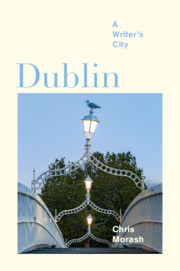Book contents
- Dublin
- Imagining Cities
- Dublin
- Copyright page
- Dedication
- Contents
- A Writer’s City: Series Preface
- Chronology
- Additional material
- Introduction The Imagined City in Time of Pandemic
- 1 Mapping the City
- 2 Baggotonia
- 3 Around St. Stephen’s Green
- 4 Trinity College
- 5 Around the Liberties
- 6 O’Connell Street and the Abbey Theatre
- 7 The North Inner City
- 8 South Dublin
- 9 The South Coast
- 10 North Dublin
- 11 Riverrun
- Read On …
- Notes
- Bibliography
- Acknowledgements
- Index
- Plate Section
1 - Mapping the City
Published online by Cambridge University Press: 16 February 2023
- Dublin
- Imagining Cities
- Dublin
- Copyright page
- Dedication
- Contents
- A Writer’s City: Series Preface
- Chronology
- Additional material
- Introduction The Imagined City in Time of Pandemic
- 1 Mapping the City
- 2 Baggotonia
- 3 Around St. Stephen’s Green
- 4 Trinity College
- 5 Around the Liberties
- 6 O’Connell Street and the Abbey Theatre
- 7 The North Inner City
- 8 South Dublin
- 9 The South Coast
- 10 North Dublin
- 11 Riverrun
- Read On …
- Notes
- Bibliography
- Acknowledgements
- Index
- Plate Section
Summary
The first chapter of Dublin: A Writer’s City provides a succinct historical framework for the spatial exploration of the city that follows, keyed to a series of historical colour maps. It begins with the earliest pre-Viking settlement, moving on to trace the evolution of Dublin from a seasonal Viking port to a walled medieval city by the beginning of the seventeenth century. From that small medieval city, Dublin in the eighteenth century grew to be a major European capital, site of a vibrant literary and print culture, which in turn gave rise to figures such as Jonathan Swift. Dublin continued to grow through the nineteenth century, until we arrive at the city of Joyce’s Ulysses in 1904. From that point onwards, the footprint of the city changes radically, as the old Georgian core is either demolished or repurposed, and new suburbs grow around the city, and these in turn develop their own literary cultures. Ultimately, this chapter suggests that we can imagine Dublin in terms of the rings in a tree, growing outwards from its historic core to new communities, each of which has a distinctive character that has been both chronicled and produced by its writers.
- Type
- Chapter
- Information
- DublinA Writer's City, pp. 12 - 31Publisher: Cambridge University PressPrint publication year: 2023



